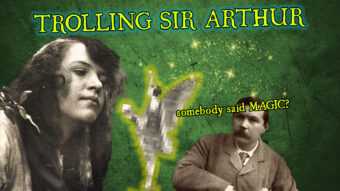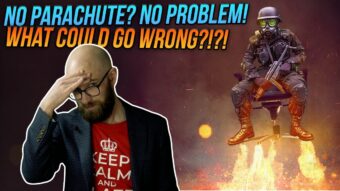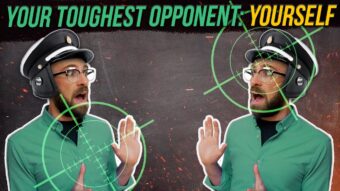
Our story begins in the summer of 1917 with sixteen-year-old Elsie Wright and ten-year-old Frances Griffiths, cousins newly arrived in the town of Cottingley, just outside Bradford in Yorkshire. Having spent much of their childhoods in South Africa, the girls found adjusting to English country life difficult and spent much of their time playing by Cottingley Beck, a nearby stream running through a narrow, rocky ravine. The girls often returned home from these excursions with wet or muddy clothes, much to their parents’ annoyance. One day, when asked why they were spending so much time at the Beck, Elsie and Frances explained that they were visiting the fairies that lived in the woods. When this excuse was unsurprisingly dismissed by the girls’ parents, Elsie borrowed her father’s glass plate camera and promised to come back with proof. The girls returned barely a half hour later, seemingly triumphant.
While dismissive of his daughter’s claims, Arthur Wright, a keen amateur photographer, nonetheless agreed to develop the exposed plates in his darkroom. As Elsie looked on, Arthur watched as the figure of his daughter emerged on the plate, lying in the grass with some small pale shapes in the foreground. At first Arthur thought them to be birds, but as the image came into focus they were revealed to be a group of four winged fairies dancing atop a bush. Overcome with excitement, Elsie cried out to her cousin waiting outside the darkroom: “The fairies are on the plate!”
Arthur Wright, however, was far from convinced. Knowing his daughter to be a skilled artist who for years delighted in drawing figures of fairies, he dismissed the photograph as a prank and the alleged fairies as merely cardboard cutouts. Two months later, however, the girls borrowed the camera again and returned with another photograph, this one depicting Elsie being greeted by a one-foot-tall winged gnome. Arthur, exasperated by what he saw as a silly prank, forbade the girls from ever borrowing his camera again. The girls, however, continued to insist that the photographs were genuine, with Frances writing in a 1918 letter to a friend in South Africa:
“Elsie and I are friendly with the beck fairies. Funny, I never used to see them in Africa. It must be too hot for them there. We all think the war will be over in a few days, we are going to get our flags to hang up in our bedroom. I am sending you two photos, both of me, one is me in a bathing costume in our back yard, uncle Arthur took that, while the other is me with some fairies up the beck, Elsie took that one. Rosebud is as fat as ever and I have made her some new clothes. How are Teddy and dolly?”
And there the story might have ended, were it not for an unexpected turn of events. For while Arthur Wright had immediately dismissed the photographs as a hoax, his wife Polly was not so certain. Both Polly Wright and Frances’ mother Annie Griffiths had recently become interested in Theosophy, an occultist religious movement founded in 1875 by Russian-American writer Helena Blavatsky. Among its many tenets, Theosophy preached the existence of nature spirits like sprites and fairies, and that certain humans possessed the ability to psychically manifest said spirits in more visible, corporeal forms. Another central belief was that humanity is undergoing a constant cycle of evolution, marching towards increasing “perfection.” If the photographs were genuine, Frances and Elsie’s ability to manifest fairies and gnomes in a form where they could be photographed would constitute strong evidence for this ongoing evolution. In 1919, Polly Wright and Annie Griffiths attended a lecture on fairies at the Theosophical Lodge in Bradford, where they approached the speaker and showed him copies of the fairy photographs.The speaker was intrigued, and the photographs soon came to the attention of Edward Gardner, a leading figure in the Theosophy movement. After examining one of the photographs for himself, Gardner wrote to Polly Wright, declaring:
“[This photograph is] the best of its kind I should think anywhere. I am keenly interested in this side of our wonderful world life and am urging a better understanding of nature spirits and fairies.”
Polly soon began an active correspondence with Gardner, answering his questions about the origins of the photographs and sending him copies of the original negatives for use in his lectures. Gardner, however, was careful to double-check the authenticity of the plates, and sent them to respected photographer Harold Snelling for examination, claiming:
“What Snelling doesn’t know about faked photography isn’t worth knowing.”
Snelling soon returned with a glowing report, assuring Gardner that:
“These two negatives are entirely genuine, unfaked photographs of single exposure, open-air work, show movement on the fairy figures, and there is no trace whatever of studio work involving card or paper models, dark backgrounds, painted figures etc. In my opinion they are both straight untouched pictures.”
Thus assured of their authenticity, in May 1920 Garner began using the Cottingley photographs in his lectures on fairies and nature spirits. It was through one of these lectures that the photographs came to the attention of Sir Arthur Conan Doyle, who had recently been assigned to write a piece on fairies for the Christmas 1920 edition of The Strand – the same magazine in which the Sherlock Holmes stories had first appeared. Doyle was immediately taken in by the photographs, and wrote to Arthur Wright asking permission to use them for his upcoming article. In the letter he referred to the images as “very interesting” and “certainly amazing” and suggested to Wright that either he or Gardner should try to “run up and have half an hour’s chat with the girls.”
In the event, Doyle found himself overwhelmed by preparations for an upcoming Australian lecture tour, and it was Gardner who made the trip to Cottingley to interview the Wrights and Griffithses. While Arthur Wright was puzzled and irritated by the whole affair, Polly and Annie stood by their daughters’ claims. After all, Elsie and Frances were by all accounts honest and truthful girls and had stuck by their story for nearly three years. Plus, they argued, how could two girls possibly have pulled off such an elaborate hoax? Now fully convinced of the photographs’ authenticity and hoping to acquire even more evidence, Gardner returned in July and provided the cousins with his own camera, later writing:
“I went off, to Cottingley again, taking the two cameras and plates from London, and met the family and explained to the two girls the simple working of the cameras, giving one each to keep. The cameras were loaded, and my final advice was that they need go up to the glen only on fine days as they had been accustomed to do before and tice the fairies, as they called their way of attracting them, and see what they could get. I suggested only the most obvious and easy precautions about lighting and distance, for I knew it was essential they should feel free and unhampered and have no burden of responsibility. If nothing came of it all, I told them, they were not to mind a bit.”
After weeks of bad weather, on August 19 the girls duly returned with two more photographs, the first showing a fairy leaping through the air near Frances’ nose and the second a fairy offering Elsie a bouquet of flowers. Two days later they returned with a fifth and final photograph, of a group of fairies sunbathing in nest made of grass. Gardner was delighted by this result, and sent an enthusiastic telegram to Doyle in Australia. Doyle’s reply was equally ecstatic:
“My heart was gladdened when out here in far Australia I had your note and the three wonderful pictures which are confirmatory of our published results. When our fairies are admitted other psychic phenomena will find a more ready acceptance … We have had continued messages at seances for some time that a visible sign was coming through.”
Doyle’s article, written before his departure and thus based on only the first two photographs, duly appeared in the Christmas edition of The Strand under the title “Fairies Photographed: an Epoch-Making Event.” Though Doyle does his best to couch his writing in cautious, skeptical language, he is unable to disguise his breathless enthusiasm and willingness to believe, the article starting off with the following preface:
“Should the incidents here narrated, and the photographs attached, hold their own against the criticism which they will excite, it is no exaggeration to say that they will mark an epoch in human thought, I put them and all the evidence before the public for examination and judgement. If I am myself asked whether I consider the case to be absolutely and finally proved, I should answer that in order to remove the last faint shadow of a doubt I should wish to see the result repeated before a disinterested witness. At the same time, I recognize the difficulty of such a request, since rare results must be obtained when and how they can. But short of final and absolute proof, I consider, after carefully going into every possible source of error, that a strong prima facie case as been built up. The cry of “fake” is sure to be raised, and will make some impression upon those who have not had the opportunity of knowing the people concerned, or the place. On the photographic side every objection has been considered and adequately met. The pictures stand or fall together. Both are false, or both are true. All the circumstances point to the latter alternative, and yet in a manner involving so tremendous a new departure one needs overpowering evidence before one can say that there is no conceivable loophole for error.”
Doyle’s arguments for the photographs’ authenticity start out relatively plausible, leaning heavily on the testimony of Harold Snelling and other photography experts, but quickly devolve into the arcane and the downright bizarre:
“In the course of our investigations we had an interesting example of the power and also of the limited of psychic knowledge. A friend who was a medium and had a control in whom he had faith was allowed to examine the prints. His report, or rather that of his control, was that there was reason to fear a fake as he saw the negative being tampered with by a fair man, short, with his hair brushed back, in a room filled with all sorts of cameras and other queer machines and devices. This was, as a matter of fact, a fairly accurate description of Mr. Snelling and his surroundings, who had, as we will be shown, prepared a second negative from the precious original.”
“To the objections of photographers that theory pictures show quite different shadows to those of the human, our answer is that the psychoplasm, as the etheric protoplasm has been named, has a faint luminosity of its own, which would largely modify the shadows.”
Doyle goes on to state that Elsie Wright was unable to draw convincing fairies from memory, citing this as evidence that she could not have possibly faked the photographs. Then, abandoning the subject of authenticity altogether, he spends a number of paragraphs meditating on various aspects of fairy biology and culture, including the species of butterflies and moths their wings most resembled and the artistic and musical traditions that might be inferred by the musical instruments they played. Finally, Doyle speculates that the fairies might actually be “thought forms” manifested by the girls’ psychic abilities, before reiterating the “epoch-making” significance of the Cottingley photographs.
The taking of the three 1920 fairy photographs inspired Doyle to write a follow-up article in the March 1921 edition of The Strand, while both pieces formed the basis for an entire book on the subject, The Coming of the Fairies, published in 1922. But while Doyle was fully taken in by the photographs, few others were fooled, and the writer soon became the laughingstock of the scientific community. Physicist Sir Oliver Lodge dismissed the photographs on the basis that the fairies sported suspiciously fashionable Parisian hairstyles, while X-ray pioneer Major John Hall-Edwards wrote:
“On the evidence I have no hesitation in saying that these photographs could have been “faked”. I criticize the attitude of those who declared there is something supernatural in the circumstances attending to the taking of these pictures because, as a medical man, I believe that the inculcation of such absurd ideas into the minds of children will result in later life in manifestations and nervous disorder and mental disturbances.”
And perhaps the most withering dismissal came courtesy of poet Maurice Hewlett, who wrote in the literary journal John O’ London’s Weekly:
“And knowing children, and knowing that Sir Arthur Conan Doyle has legs, I decide that the Miss Carpenters have pulled one of them.”
But Doyle was not without his supporters – mostly from the occultist community – with novelist Henry de Vere Stacpoole writing:
“Look at [Frances’] face. Look at [Elsie’s] face. There is an extraordinary thing called Truth which has 10 million faces and forms – it is God’s currency and the cleverest coiner or forger can’t imitate it.”
By this time, however, interest in the Cottingley Fairies was rapidly waning. Elsie and Frances had grown tired of the whole affair, and eventually married and moved abroad. Yet for decades they continued to maintain that the photographs were genuine, with Elsie speculating in a 1971 TV interview that the fairies might have been merely figments of her imagination and that she had somehow managed to photograph her thoughts. It was not until shortly before their deaths in the late 1980s that the cousins finally confessed to having faked the photographs. While skeptics had variously speculated that the girls had used costumed dancers, double-exposures, and other photographic trickery to create the images, the actual technique turned out to be embarrassingly crude. The fairies were, as Arthur Wright had suspected from the beginning, merely cardboard cutouts, copied from a popular children’s book and propped up using hat pins. These props were then thrown into Cottingley Beck once the photographs were taken, destroying all evidence of the hoax. Strangely, however, the cousins only admitted to faking the first four photographs, maintaining to their dying day that the fifth photograph was genuine and that they actually had seen fairies by the Beck. Photography experts now believe the fifth photograph to be an unintentional double exposure, with an image of the fairy cutouts lying on the ground superimposed over an image of a grass nest. This would explain why the fairies in the photograph appear more three-dimensional than in the others and why neither girl could remember faking that particular image. As for why the cousins had stuck to their story for so long, Frances explained that the story had grown far beyond their ability to deny it:
“Two village kids and a brilliant man like Conan Doyle – well, we could only keep quiet. I never even thought of it as being a fraud – it was just Elsie and I having a bit of fun and I can’t understand to this day why they were taken in – they wanted to be taken in.”
While it might perhaps be difficult to understand why a man of Doyle’s prodigious intellect could be taken in by such an obvious prank, in reality Doyle’s temperament and life experiences made him an ideal target for such hoaxes. As a child Doyle spent a great deal of time in the company of his uncle Richard Doyle, a prolific illustrator whose drawings of fairies, elves, and other mythical creatures appeared in countless children’s book. From this relationship Doyle developed a fascination with nature spirits that remained with him for the rest of his life. Furthermore, starting in 1916, Doyle became a devotee of Spiritualism, a religious movement which held that the afterlife was real and that the spirits of the departed could be contacted through mediums and seances. Though founded in the 1840s, the Spiritualist movement exploded in popularity in the wake of the First World War, as the bereaved families of millions of fallen soldiers flocked to the notion that their loved ones were never really gone. Indeed, Doyle himself had lost his eldest son Kingsley in conflict, further strengthening his convictions. The massive sense of disillusionment wrought by the War made people ready and willing to accept whimsical, uplifting tales of nature spirits, and if people could be made to accept fairies, Doyle believed, they would be more willing to accept the spiritualist beliefs he held so dear. For as his 1920 article in The Stand concludes:
“I must confess that after months of thought I am unable to get the true bearings of this event. One or two consequences are obvious. The experiences of children will be taken more seriously. Cameras will be forthcoming, Other well-authenticated cases will come along. These little folk who appear to be our neighbours, with only some small difference of vibration to separate us, will become familiar. The thought of them, even when unseen, with add a charm to every brook and valley and give romantic interest to every country walk. The recognition of their existence will jolt the material twentieth-century mind out of its heavy ruts in the mud, and will make it admit that there is a glamour and mystery to life. Having discovered this, the world will not find it so difficult to accept that spiritual message supported by physical facts which has already been so convincingly put before it.”
Thus, while the story of the Cottingley Fairies Hoax is often remembered as an embarrassing episode in which a purported champion of logic and reason was duped by a pair of schoolgirls, it can also be seen as an example of how the cataclysmic trauma of the Great War forever changed society – sometimes in the most unexpected of ways.
If you liked this article, you might also enjoy our new popular podcast, The BrainFood Show (iTunes, Spotify, Google Play Music, Feed), as well as:
- The Surprisingly Recent Time Period When Boys Wore Pink, Girls Wore Blue, and Both Wore Dresses
- Was One of the Bond Girls Really Formerly a Man?
- The First British Surgeon to Perform a Successful C-Section Was a Woman Disguised as a Man
Conan Doyle, Arthur, Fairies Photographed: an Epoch-Making Event, https://ift.tt/gzDQemG
Museum Acquires Final Camera in the Cottingley Fairies Story, Science and Media Museum, Bradford, December 9, 2019, https://www.scienceandmediamuseum.org.uk/about-us/press-office/museum-acquires-final-camera-cottingley-fairies-story
Hester, Jessica, For Sale: Legendary Photographic ‘Proof’ of Fairies and Gnomes, Atlas Obscura, September 28, 2018, https://web.archive.org/web/20181003183323/https://www.atlasobscura.com/articles/cottingley-fairies-photographs-for-sale?ct=t%28EMAIL_CAMPAIGN_10_2_2018%29&mc_cid=d153f00e17&mc_eid=9f3ca0a886
The Coming of the Fairies: an Alternative View of the Episode of the Cottingley Fairies, The Arthur Conan Doyle Society, https://web.archive.org/web/20100917124859/http://ash-tree.bc.ca/acdsfairies.htm
Clayton, Emma, Cottingley Fairies Back in the Spotlight, The Telegraph and Argus, July 14, 2009, https://ift.tt/KrUVXeY
The post How a Couple of British School Girls Fooled the Creator of Sherlock Holmes Into Publicly Declaring Fairies Exist appeared first on Today I Found Out.



0 comments:
Post a Comment
Please ,
Don't enter span link